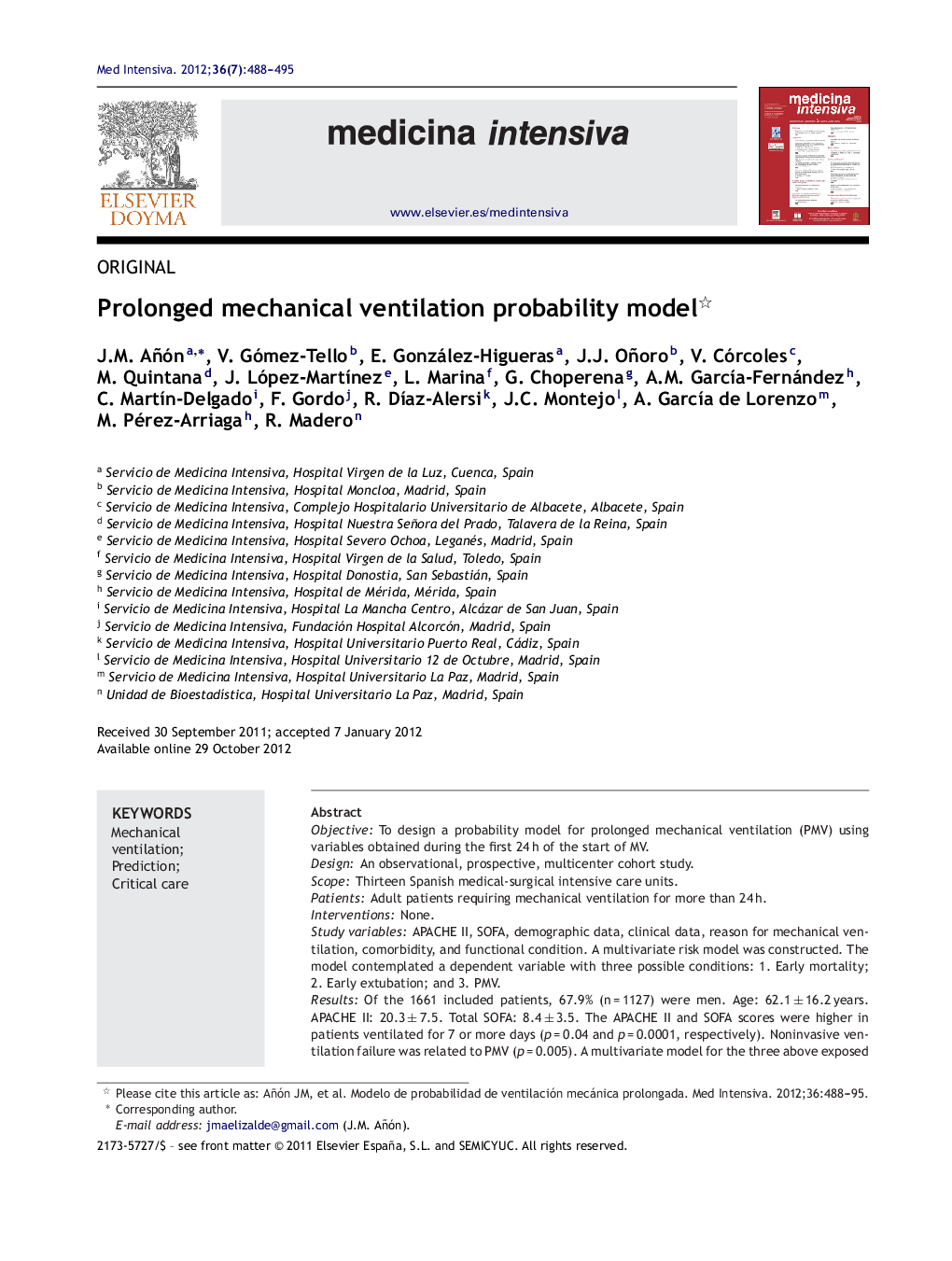| کد مقاله | کد نشریه | سال انتشار | مقاله انگلیسی | نسخه تمام متن |
|---|---|---|---|---|
| 3114276 | 1192508 | 2012 | 8 صفحه PDF | دانلود رایگان |

ObjectiveTo design a probability model for prolonged mechanical ventilation (PMV) using variables obtained during the first 24 h of the start of MV.DesignAn observational, prospective, multicenter cohort study.ScopeThirteen Spanish medical-surgical intensive care units.PatientsAdult patients requiring mechanical ventilation for more than 24 h.InterventionsNone.Study variablesAPACHE II, SOFA, demographic data, clinical data, reason for mechanical ventilation, comorbidity, and functional condition. A multivariate risk model was constructed. The model contemplated a dependent variable with three possible conditions: 1. Early mortality; 2. Early extubation; and 3. PMV.ResultsOf the 1661 included patients, 67.9% (n = 1127) were men. Age: 62.1 ± 16.2 years. APACHE II: 20.3 ± 7.5. Total SOFA: 8.4 ± 3.5. The APACHE II and SOFA scores were higher in patients ventilated for 7 or more days (p = 0.04 and p = 0.0001, respectively). Noninvasive ventilation failure was related to PMV (p = 0.005). A multivariate model for the three above exposed outcomes was generated. The overall accuracy of the model in the training and validation sample was 0.763 (95%IC: 0.729–0.804) and 0.751 (95%IC: 0.672–0.816), respectively. The likelihood ratios (LRs) for early extubation, involving a cutoff point of 0.65, in the training sample were LR (+): 2.37 (95%CI: 1.77–3.19) and LR (−): 0.47 (95%CI: 0.41–0.55). The LRs for the early mortality model, for a cutoff point of 0.73, in the training sample, were LR (+): 2.64 (95%CI: 2.01–3.4) and LR (−): 0.39 (95%CI: 0.30–0.51).ConclusionsThe proposed model could be a helpful tool in decision making. However, because of its moderate accuracy, it should be considered as a first approach, and the results should be corroborated by further studies involving larger samples and the use of standardized criteria.
ResumenObjetivoDiseñar un modelo de probabilidad de ventilación mecánica prolongada (VMP) con variables clínicas obtenidas durante las primeras 24 horas de su instauración.DiseñoEstudio de cohorte, observacional, prospectivo, multicéntrico.ÁmbitoTrece UCI españolas polivalentes.PacientesAdultos ventilados durante más de 24 horas.IntervencionesNinguna.Variables de interésAPACHE II, SOFA, variables clínicas y demográficas, motivo de VM, comorbilidad y estado funcional. Se construyó un modelo de riesgo multivariante en el que la variable dependiente tenía tres posibles estados: 1.- Muerte precoz. 2.- Retirada precoz de la VM. 3.- VMP.ResultadosSe incluyeron 1.661 pacientes. El 67,9% (n = 1.127) fueron hombres. Edad: 62,1 ± 16,2 años. APACHE II: 20,3 ± 7,5. SOFA: 8,4 ± 3,5. Las puntuaciones APACHE II y SOFA fueron mayores en pacientes ventilados ≥ 7 días (p = 0,04 y p = 0,0001 respectivamente). El fracaso de la ventilación no invasiva (VNI) se asoció a VMP (p = 0,005). Se generó un modelo de riesgo multivariante con las siguientes variables: APACHE II, SOFA, fracaso de VNI, ubicación hospitalaria antes del ingreso en UCI y motivo de ventilación mecánica. La exactitud del modelo global fue de: 0,763 (95% IC: 0,729-0,804) para la muestra de diseño y 0,751 (95% IC: 0,672-0,816) para la muestra de validación. Las razones de verosimilitud (likelihood ratio–LR-) en el modelo de extubación precoz para un punto de corte de 0,65 en la muestra de diseño fueron LR (+): 2,37 (IC 95% 1,77-3,19); LR (−): 0,47 (IC 95%: 0,41-0,55). En el modelo exitus y para un punto de corte de 0,73 en la muestra de diseño fueron LR (+): 2,64 (IC 95%: 2,01-3,4); LR (−): 0,39 (IC 95%: 0,30-0,51).ConclusionesEl modelo propuesto podría constituir una herramienta de ayuda para la toma de decisiones clínicas aunque debido a la moderada exactitud del mismo se debe considerar como una primera aproximación y los resultados deberán ser corroborados en estudios futuros con muestras más amplias y criterios de estandarización.
Journal: Medicina Intensiva (English Edition) - Volume 36, Issue 7, October 2012, Pages 488–495